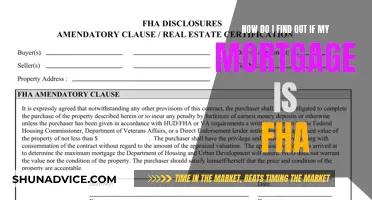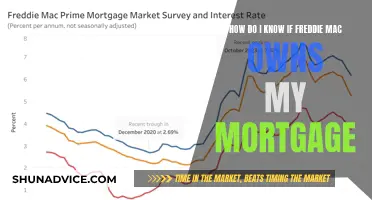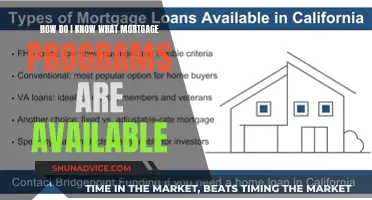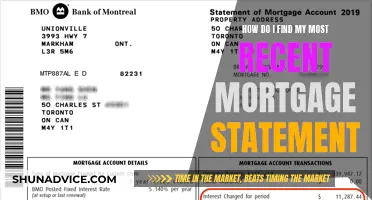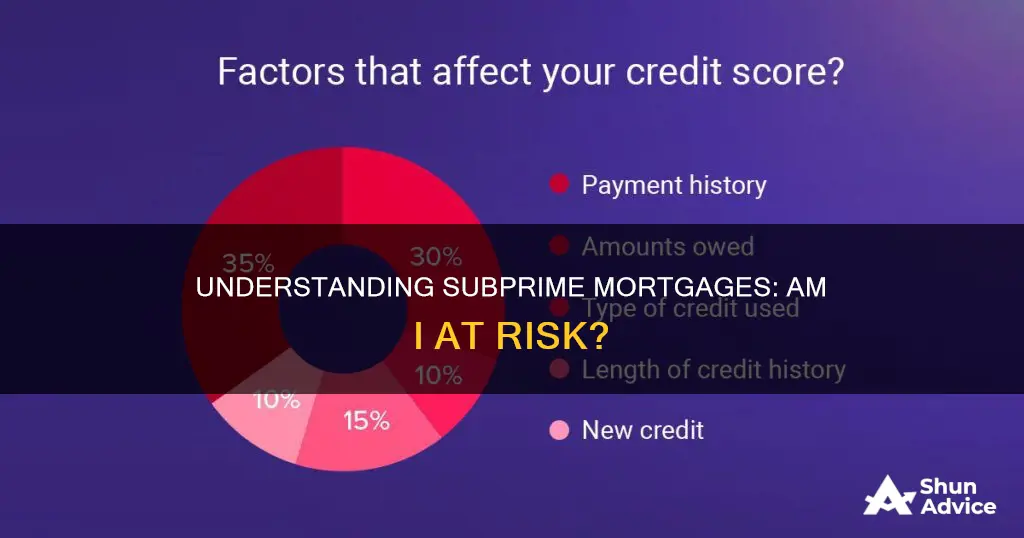
A subprime mortgage is a type of loan granted to individuals with poor credit scores who wouldn't qualify for conventional mortgages. Subprime borrowers are more likely to default than those with higher credit scores, and as a result, they tend to have a more difficult time qualifying for new credit accounts. While there is no single point at which a credit score crosses into the subprime range, a FICO® Score of 669 or lower is often considered subprime. If you have a low credit score, you may have a subprime mortgage, and you may be paying more than those with prime mortgages.
| Characteristics | Values |
|---|---|
| Credit score | FICO scores below 640, 620, or 600 are typically classified as subprime. The Consumer Financial Protection Bureau classifies scores between 619 and 580 as subprime. Experian found that a score of 669 or lower is often considered subprime. |
| Lender risk | Subprime borrowers are seen as having a greater-than-average risk of defaulting on a loan. |
| Interest rates | Subprime mortgages have higher interest rates to compensate for the higher risk. |
| Mortgage types | Subprime mortgages are often adjustable-rate mortgages (ARMs) or interest-only mortgages. |
| Lender options | Subprime borrowers have fewer options for borrowing money and may have to pay more in fees and interest. |
| NINJA loans | Subprime mortgages can be issued with no down payment or proof of income. |
What You'll Learn
- Subprime mortgages are for borrowers with low credit scores
- Subprime borrowers may have to pay more in fees and interest
- Subprime mortgages are often adjustable-rate mortgages (ARMs)
- Subprime borrowers may have trouble making all their loan payments on time
- Subprime mortgages are making a comeback as non-prime mortgages

Subprime mortgages are for borrowers with low credit scores
Subprime mortgages are loans offered to borrowers with low credit scores, usually below 600. These borrowers are considered to have a greater-than-average risk of defaulting on their loans. As a result, subprime mortgages often come with higher interest rates to compensate lenders for taking on the additional risk.
While the specific definition of a subprime borrower varies across lenders, they are generally considered to have a FICO® Score of 669 or lower. These borrowers may struggle to obtain credit or qualify for new credit accounts and may have to pay more in fees and interest when they are approved. Subprime borrowers may also have a harder time obtaining a mortgage and may be subject to higher interest rates if they do qualify.
The term "subprime" refers to the below-average credit score of the individual taking out the mortgage, indicating an increased risk of default. These borrowers typically have credit scores below 620 and may have other negative information in their credit reports. In the past, FICO scores below 640, 620, or 600 have been classified as subprime cut-offs.
Subprime mortgages are often adjustable-rate mortgages (ARMs), which means the interest rate can increase at specified times. The high-interest rates associated with subprime mortgages can make it challenging for borrowers to keep up with their payments, potentially leading to default. This was evident during the 2008 housing market crash, which was largely attributed to widespread defaults on subprime mortgages.
Despite the challenges, subprime mortgages can provide an opportunity for individuals with low credit scores to become homeowners without having to spend years building a better credit history. Subprime borrowers can also use these mortgages to improve their credit scores by making timely payments. However, it is important to carefully consider the risks and potential costs associated with subprime mortgages, including higher closing costs and fees.
Accessing Your Mortgage Statement: A Quick Guide
You may want to see also

Subprime borrowers may have to pay more in fees and interest
Subprime borrowers are considered a higher credit risk for lenders. This means that subprime borrowers may have to pay more in fees and interest. Subprime borrowers have lower credit scores and are likely to have multiple negative factors in their credit reports. This means that subprime borrowers are statistically more likely to miss a debt payment in the future. As a result, subprime borrowers tend to have a more difficult time qualifying for new credit accounts.
Lenders differentiate among mortgage applicants by using loan risk grades based on their past mortgage or rent payment behaviours, previous bankruptcy filings, debt-to-income (DTI) ratios, and the level of documentation provided by the applicants to verify income. Lenders then determine the price of a mortgage in a given risk grade based on the borrower’s credit risk score and the size of the down payment. Subprime borrowers are likely to be charged higher upfront origination fees (e.g. application fees) and prepayment penalties.
Subprime mortgages are also likely to have higher interest rates than prime mortgages. These higher interest rates are intended to compensate the lender for accepting the greater risk in lending to such borrowers. The interest rate on subprime mortgages can rise significantly over time, making it very hard to pay down the mortgage principal. Subprime borrowers may also have to pay larger down payments than those with prime mortgages.
Is Your Mortgage Secured? What You Need to Know
You may want to see also

Subprime mortgages are often adjustable-rate mortgages (ARMs)
A subprime mortgage is a loan offered to borrowers with impaired credit records or low credit scores. Subprime borrowers are often considered to have a greater-than-average risk of defaulting on their loans. Because of this increased risk, subprime mortgages usually come with higher interest rates than prime mortgages.
ARMs often start with a low fixed interest rate during an introductory period, which can last for three, five, seven, or ten years. After this period, the interest rate will adjust periodically based on the benchmark rate. If the benchmark rate has increased, the borrower's interest rate and monthly payments will also increase. Conversely, if the benchmark rate has decreased, the borrower's payments will be lower.
Because of the potential for significant increases in interest rates and monthly payments, ARMs are generally best suited for borrowers who do not intend to stay in their homes for a long time. For example, if a borrower plans to sell their home before the end of the introductory fixed-rate period, they can take advantage of the initially lower payments without having to worry about potential increases down the line.
Finding Mortgage Records: A Comprehensive Guide
You may want to see also

Subprime borrowers may have trouble making all their loan payments on time
Subprime borrowers are those with a low credit score, which may indicate a greater risk of defaulting on loans. While there is no single point at which a credit score becomes subprime, a FICO® Score of 669 or lower is often considered subprime. These borrowers tend to have a more difficult time qualifying for new credit accounts and may have to pay more in fees and interest.
Subprime borrowers are more likely to miss debt payments and may have trouble making all their loan payments on time. This is because subprime loans have higher interest rates, which can make them harder to service, especially for borrowers who already have financial troubles. The interest rates on subprime loans can be 8-10% higher than prime loans, which can translate into tens of thousands of dollars in additional interest payments over the life of a loan.
Subprime loans are often considered predatory, locking borrowers into debt and increasing their likelihood of defaulting. For example, many subprime borrowers were granted NINJA loans, an acronym for "no income, no job, and no assets." These loans were issued with no down payment and no proof of income required, and the interest rates started low and then ballooned over time, making it very hard for borrowers to pay down the mortgage principal. This was a key factor in the 2008 financial crisis, which was largely due to widespread defaults on subprime mortgages.
However, subprime loans can also provide borrowers with the opportunity to purchase a home without having to wait, and if they are able to make timely mortgage payments, their credit scores can improve over time, allowing them to refinance to a prime loan. Additionally, subprime loans can be a sensible option for paying off debts with higher interest rates, such as credit cards, or for borrowers who have no other means of obtaining credit.
Understanding Collateral Mortgages: What You Need to Know
You may want to see also

Subprime mortgages are making a comeback as non-prime mortgages
Subprime mortgages are typically granted to individuals with poor credit scores who wouldn't qualify for conventional mortgages. They are considered high-risk for lenders and usually come with higher interest rates. In the past, different lenders used different rules to define subprime loans, but FICO scores below 640, 620, or 600 were often classified as subprime.
Following the 2008 housing market crash, which was largely due to widespread defaults on subprime mortgages, these types of loans disappeared. However, as the economy improves and rents continue to rise, subprime mortgages are making a comeback under a new name: non-prime mortgages. This demand from both borrowers and investors is exceeding expectations. Companies like Carrington Mortgage Services and Angel Oak are now offering mortgages to borrowers with "less-than-perfect credit".
Non-prime mortgages are similar to the subprime mortgages of the past, in that they are designed for borrowers with impaired credit records. These borrowers are considered to have a greater-than-average risk of defaulting on loans. As a result, lenders often charge interest on non-prime mortgages at a much higher rate than on prime mortgages to compensate for the increased risk. These are often adjustable-rate mortgages (ARMs), meaning the interest rate can increase over time.
While the term "subprime" may have negative connotations, the concept of non-prime mortgages aims to provide an opportunity for individuals with poor credit scores to obtain home loans. However, it is important to note that these loans come with higher costs and may require down payments of up to 25% to 35%. Borrowers should carefully consider their ability to handle debt and be aware of the potentially expensive future that lies ahead if they choose to take on these loans.
Who Owns My Mortgage? Finding Your Mortgage Investor
You may want to see also
Frequently asked questions
Subprime mortgages are typically for borrowers with a credit score below 600. Different lenders will use different rules for what constitutes a subprime loan, but FICO scores below 640, 620, or 600 have typically been classified as subprime cut-offs. Experian found that a FICO® Score of 669 or lower is often considered subprime.
A subprime mortgage is a type of loan granted to individuals with poor credit scores who wouldn't qualify for a conventional mortgage. Subprime mortgages usually charge interest rates above the prime lending rate.
The main types of subprime mortgages are fixed-rate mortgages, interest-only mortgages, and adjustable-rate mortgages (ARMs).



